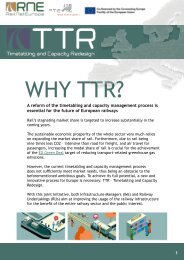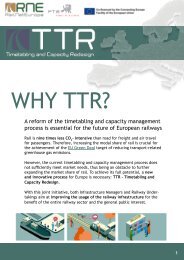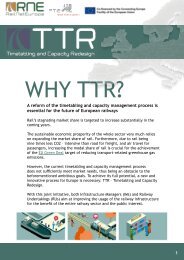TTR_Extended_Brochure_2023
Create successful ePaper yourself
Turn your PDF publications into a flip-book with our unique Google optimized e-Paper software.
… And How <strong>TTR</strong> Will<br />
Overcome Them<br />
With the Capacity Strategy and a Capacity Model, IMs allocate capacity to<br />
various needs (freight, passengers, TCRs) from the beginning. These deliverables<br />
contribute to safeguarding commercial capacity of good quality,<br />
in particular for long distance traffic. On top of that, with improved RU<br />
consultation, the needed clustering of TCRs by their impact, and last but not<br />
least, the TCR Tool for optimised communication and planning, <strong>TTR</strong> provides<br />
solutions for an internationally coordinated approach to minimise negative<br />
impacts.<br />
Through advanced planning with Capacity Models, leading to an acceleration<br />
of the allocation process, passenger RUs can sell their tickets several months<br />
in advance, thus becoming more competitive.<br />
Differentiated timetabling products – several of which will build on<br />
safeguarded capacity – will serve the diverse market needs: annual timetable<br />
requests will be complemented by possibilities to request capacities shortly<br />
before the train run through high-quality, nationally and internationally<br />
harmonised capacity products.<br />
<strong>TTR</strong> stands for the Europe-wide and cross-border harmonisation of all<br />
relevant timetabling processes to facilitate international rail traffic and<br />
make work easier for both Infrastructure Managers and Railway Undertakings.<br />
Specif-ically, a common IT infrastructure and the adaptation of a <strong>TTR</strong>supportive<br />
legal framework will be key.<br />
Digital Capacity Management (DCM) as integral IT-part of <strong>TTR</strong> will connect a<br />
multitude of national IT systems to a central business layer, thus ensuring<br />
compatibility. It will allow quick communication and enable easier<br />
amendments – no matter the type of traffic, domestic or international,<br />
passenger or freight.<br />
Digitilsation of national and international layers will minimise manual work<br />
load and lead times in capacity planning and path allocation. It will assist in<br />
optimisation and will benefit both RUs and IMs.








